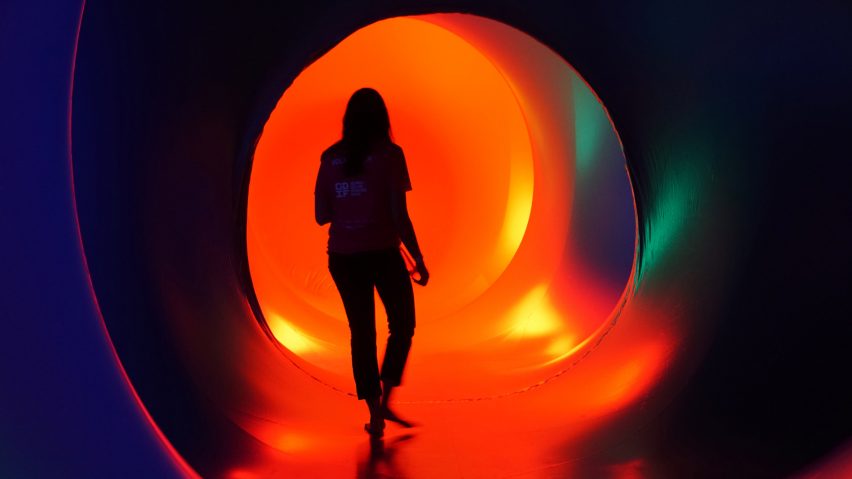The Daedalum maze, which consists of 19 interconnected egg-shaped domes made from translucent material, is the latest piece of inflatable architecture designed by Alan Parkinson, founder of Architects of Air.
Named after Daedalus – the architect of the Labyrinth of Minos in Greek mythology – the blow-up maze was created to let people experience the "phenomenon of light".
Architects of Air installed the inflatable structure at the Royal Albert Dock, in London, from 21 to 23 June as part of the Greenwich + Docklands International Festival.
"I design the structures to create a particular encounter with the phenomenon of light," Parkinson told Dezeen. "I devise an architecture to encourage a sense of wonder."
The latest maze in a succession of inflatable mazes designed by Architects of Air, Daedalum is constructed from a variety of different coloured pieces of translucent material to create varied light-filled spaces.
"Daedalum aims to be the most mysterious of our luminaria in terms of the journey that visitors would take inside," Alan Parkinson explained.
"The key influences are the structures that preceded Daedalum – each new structure we build gives indicators for what we do with the next. I do have a fondness for Islamic architecture, geometric solids – structures that lend themselves to be interpreted pneumatically."
Visitors enter the maze through an air lock, after taking their shoes off, before exploring the interconnecting series of domes and tunnels.
Along with the numerous smaller domes, the far end of the maze, which is 47 metres long and 31 meters wide, opens up with two larger structures.
Designed by Alan Parkinson's son, Meko the Tree and the Main Dome are the most open spaces within the maze.
Described as "an adventurous assembly of intersecting volumes", The Tree appears like a stack of intersecting bubbles above visitors' heads.
The Main Dome is topped with a pattern made of 600 pieces of fabric.
Designed to create various colours inside as the sun moves across the sky, the dome was inspired by both Rome's Pantheon and Gustave Doré drawing of angels in Dante's paradise.
Alan Parkinson believes that building temporary inflatable structures allows him to explore what architecture aims to be, while still having to deal with practical issues that purely theoretical projects do not.
"It is transient and aspires to be utopian in a way that permanent architecture, with its feet on the ground is often not allowed to be," he explained.
"That said, in practical terms, we have to engage with the parameters that actual architecture engages with – wind-loading, drainage, temperature control and wheelchair accessibility."
Numerous designers around the world are exploring the potential of inflatable architecture.
Last year architects Thomas Randall-Page and Benedetta Rogers created an inflatable yellow theatre barge on an east London canal, while the Nordic Pavilion at the Venice Architecture Biennale contained air-filled pods that expanded and contracted based on changing environmental conditions.
Photography is courtesy of Architects of Air.

